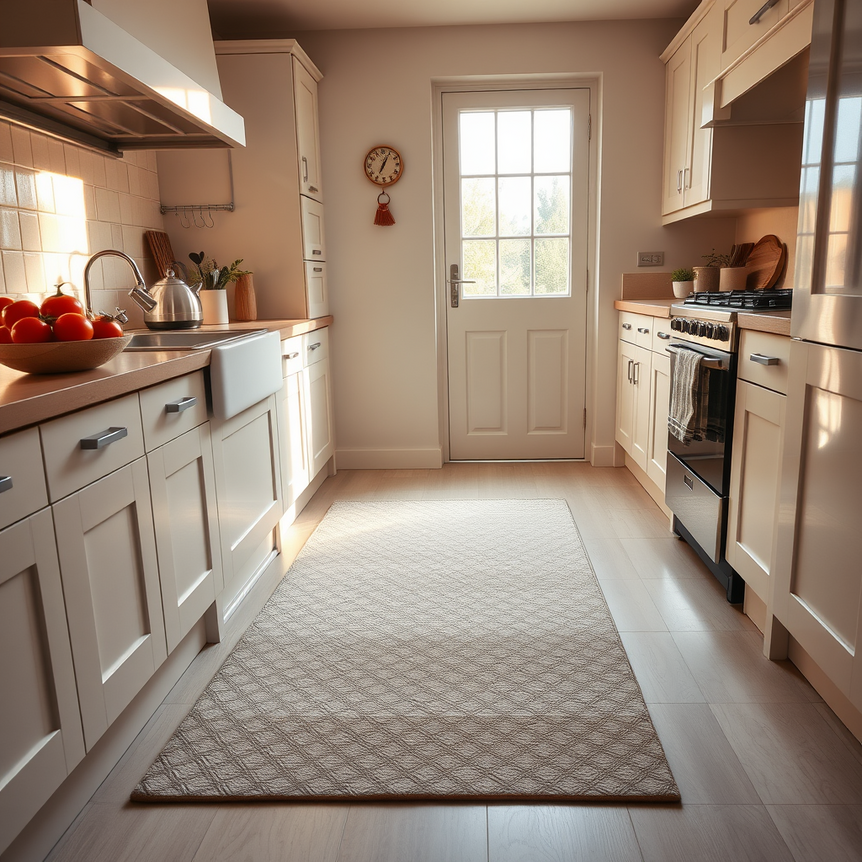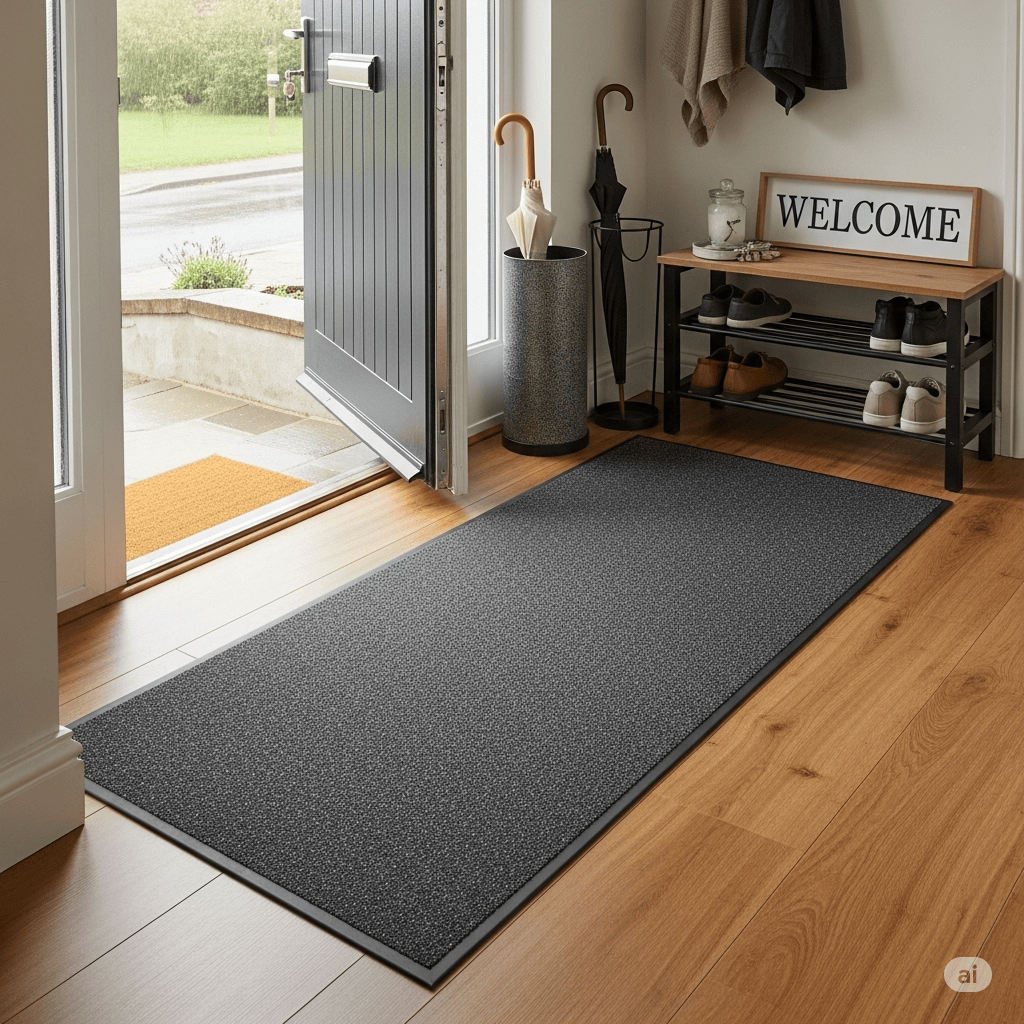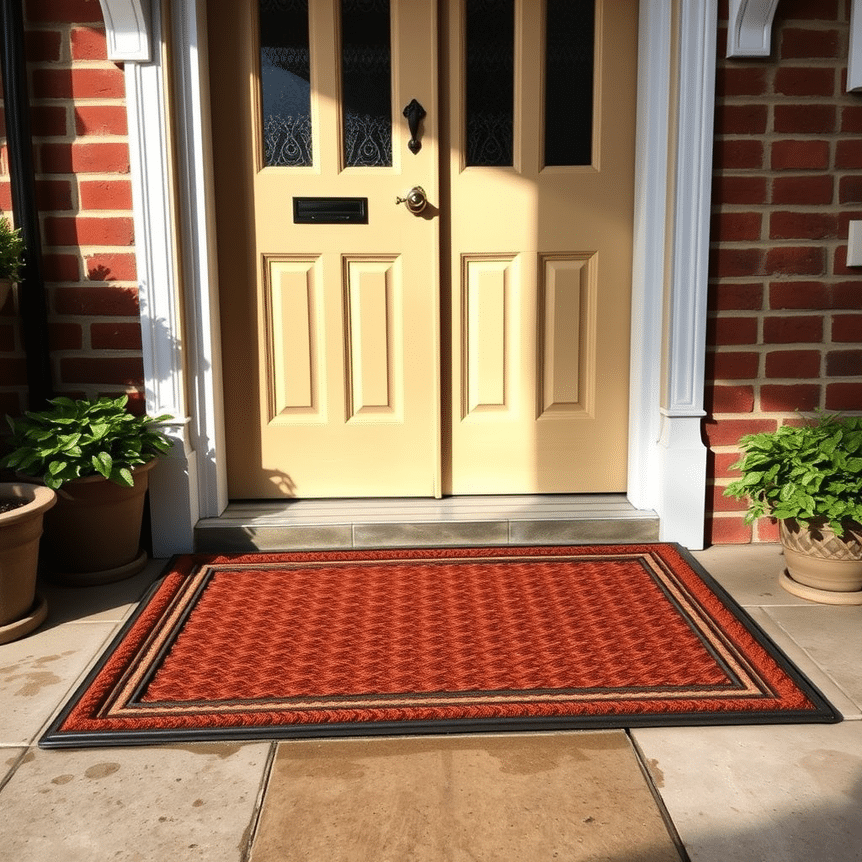A well-chosen kitchen runner rug offers essential durability and comfort in the busiest spaces of UK homes. From protecting floors against heavy foot traffic to providing cushioning during long cooking sessions, the right rug enhances both function and style. Here’s a comprehensive guide to selecting a heavy-duty kitchen runner rug tailored for the unique demands of UK kitchens, ensuring your choice offers long-lasting performance and aesthetic appeal.
The Essential Role of Kitchen Runner Rugs in High-Traffic UK Homes
Busy UK kitchens experience constant movement, spills, and moisture, making them one of the most demanding areas in any home. A kitchen runner rug specifically designed for durability ensures longevity by resisting daily wear and tear. Beyond protection, these robust kitchen mats provide crucial comfort underfoot, reducing fatigue while cooking, cleaning, or entertaining. Additionally, runners help define kitchen zones, soften hard flooring, and add warmth to bustling household hubs, contributing significantly to both the practicality and aesthetic of your space. They are an excellent solution for washable kitchen rugs that withstand the demands of active family life.
Tailoring Your Kitchen Runner Rug to UK Home Needs
UK kitchen layouts vary widely—from narrow galley kitchens to spacious open-plan designs—significantly impacting how a rug functions and performs. Consider the specific patterns of foot traffic in your home and the rug’s placement, especially near sinks, dishwashers, or cooking areas prone to spills and moisture exposure. It’s crucial to choose materials and constructions that offer superior moisture resistance and quick-drying capabilities to prevent the build-up of mould and mildew. Furthermore, safety features like integrated anti-slip backings are vital in family homes to reduce trip and slip hazards, ensuring a secure environment even on wet floors. Investing in a quality heavy-duty kitchen runner rug means prioritising both longevity and safety for your household.
Mastering Size Selection for UK Kitchens
The ideal kitchen runner seamlessly fits the kitchen’s main traffic way without overwhelming the space or looking out of proportion. Standard widths typically range from 60cm to 80cm (24 to 32 inches), providing enough coverage for walkways while maintaining visible flooring edges for balance and an uncluttered look. The appropriate length depends largely on your kitchen type and specific layout:
- Galley Kitchens: For these elongated spaces, runners between 180cm to 270cm (70 to 106 inches) allow for comprehensive coverage along the full corridor, providing continuous comfort and protection.
- Open-Plan Kitchens: In larger, more expansive open-plan designs, opt for more extended runners that can effectively anchor seating areas or specific work zones, helping to define the space.
- Island Kitchens: For kitchens featuring a central island, choose a runner that extends just beyond both ends of the island (approximately 15-20cm or 6-8 inches) to create visual harmony and a sense of completeness.
As a general rule, aim to leave about 10 to 15cm (4 to 6 inches) of floor visible on each side of the runner. This small border prevents the rug from looking cramped or making the space feel smaller, contributing to a well-balanced aesthetic.
Choosing Durable Materials Made for UK Conditions
Heavy-duty kitchen runners for UK homes benefit immensely from performance fabrics specifically engineered to withstand frequent spills, heavy foot traffic, and regular cleaning. The right material ensures your rug not only looks good but also maintains its integrity over time. Here’s a comparison of common materials:
Material Comparison for Kitchen Runner Rugs
| Material Type | Key Characteristics | Pros for Kitchen Use | Cons for Kitchen Use |
|---|---|---|---|
| Wool Blends | Natural fibres, often mixed for enhanced performance. | Naturally durable, excellent stain and soil resistance, soft underfoot, insulates. | Can be more expensive, may take longer to dry, some blends not fully machine washable. |
| Acrylics | Synthetic, often mimics wool texture. | Affordable, fade-resistant, quick-drying, moth-proof, easy to clean. | Less durable than wool for extreme traffic, can feel less luxurious. |
| Polyester | Synthetic, known for softness and colour retention. | Fade-resistant, soft, good colour vibrancy, often made from recycled materials, good stain resistance with treatment. | Can flatten in high-traffic areas, may show oil-based stains more readily. |
| Cotton | Natural fibre, absorbent. | Soft, highly washable, breathable, good for casual styles. | Less resistant to moisture and stains without special treatments, can take longer to dry, prone to shrinking. |
Flat-weave constructions are particularly recommended as they facilitate easy cleaning and offer superior durability, resisting flattening over time even in busy environments. Opting for solution-dyed fabrics is also highly beneficial; this process locks colour directly into the fibres during manufacturing, preventing fading despite frequent washing, exposure to sunlight, and general household use. This ensures your washable kitchen rug retains its vibrant appearance for years.
Prioritizing Safety with Anti-Slip and Backing Technologies
Safety is paramount in busy kitchen environments, where spills and moisture are common. Runners with advanced anti-slip backing significantly reduce the risk of slips and falls, eliminating the need for cumbersome and separate rug underlays. When choosing your heavy-duty kitchen runner, it’s essential to compare the different backing technologies available:
Types of Anti-Slip Backings
- Latex and Gel-Backed Rugs: These options offer a strong, reliable grip on various floor types, including hardwood, tile, and laminate. They are flexible, allowing the rug to lay perfectly flat and securely, preventing edges from curling up. Latex and gel backings are generally considered safe for most flooring.
- Rubber Backing: While effective at providing grip, rubber backing can sometimes trap moisture underneath, which, over time, could potentially harm certain types of flooring, especially hardwood, by leading to discolouration or degradation. It’s crucial to check compatibility with your specific flooring type if considering a rubber-backed rug.
Selecting runners with built-in anti-slip technology provides crucial peace of mind and contributes to safer household movement, making your kitchen a more secure place for everyone.
Designing Your Kitchen Runner Rug to Complement British Interiors
A well-chosen kitchen runner rug can seamlessly elevate any British kitchen style, adding both practicality and aesthetic appeal. The key is to select colour palettes, patterns, and textures that harmonise with your existing cabinetry, flooring, and overall décor. Consider these design tips:
- Contemporary Kitchens: For modern British interiors, opt for bold stripes, striking geometric patterns, or sophisticated monochrome palettes (blacks, whites, greys). These choices add a crisp, clean, and dynamic feel.
- Traditional Kitchens: In classic or farmhouse-style British kitchens, florals, subtle bordered edges, or muted earth tones (such as sage green, deep blues, or warm terracotta) beautifully complement existing designs, enhancing their cosy and timeless charm.
Neutrals and soft hues are always a timeless choice, offering versatility and adaptability as your decor evolves. Alternatively, patterned runners are excellent for masking minor spills and everyday stains, while also adding significant visual interest and personality to your kitchen space.
Prolonging Rug Life: Easy Maintenance Tips for Busy UK Homes
Maintaining your heavy-duty kitchen runner is straightforward, ensuring its longevity and appearance, especially when you follow appropriate cleaning routines:
- Regular Vacuuming: Vacuum your runner at least once a week to prevent the accumulation of dirt, dust, and debris. Use a vacuum cleaner with adjustable settings to avoid damaging flat-weave or anti-slip backings.
- Spot Cleaning: Act immediately after spills. Use a clean cloth and a mild detergent solution to blot the affected area gently. Avoid rubbing, which can spread the stain. For stubborn stains, consult the manufacturer’s specific cleaning recommendations.
- Machine Washable Options: Some heavy-duty runners are designed to tolerate gentle washing cycles. Always check the manufacturer’s guidelines and care label before machine washing to ensure the rug maintains its integrity and colour. Use cold water and a mild detergent, and air dry if possible.
Crucially, avoid using harsh chemicals, bleach, or excessively soaking the rug, as these can degrade backing adhesives, compromise fabric integrity, and cause discolouration. Proper care ensures your durable kitchen mat remains a functional and attractive asset for years.
Perfect Placement: Installation Tips for Maximum Impact and Safety
Strategic placement of your kitchen runner is key to maximising its impact on both safety and aesthetics. Place your runner where you stand most often—commonly near sinks, cooktops, dishwashers, or main preparation areas. This ensures comfort where it’s needed most and protects high-traffic zones. Additionally:
- Ensure Flatness: Always ensure the rug lies perfectly flat without any curling edges, which can create significant tripping hazards. If edges curl, try reverse-rolling the rug or using rug grippers specifically designed to flatten corners.
- Anchor Kitchen Islands/Counters: When installed near a kitchen island or counter, extend the runner slightly beyond the furniture (about 15 to 20cm / 6 to 8 inches) on both ends. This visually anchors the space, creates a cohesive look, and avoids awkward gaps or a ‘floating’ appearance, enhancing both functionality and design harmony.
Proper placement not only boosts the visual appeal of your kitchen but also significantly contributes to a safer, more comfortable cooking and living environment.
Why Investing in Heavy-Duty Kitchen Runner Rugs Pays Off
Investing in a heavy-duty kitchen runner rug is a smart financial decision that brings numerous long-term benefits to your home. These durable kitchen mats are a vital investment that protects your existing flooring from wear, scratches, and spills, effectively extending its lifespan and reducing potential repair or replacement costs. Beyond protection, they significantly enhance comfort, reducing fatigue during prolonged standing periods, making cooking and cleaning more enjoyable. By choosing durable materials and superior backing, your runner will withstand the rigours of heavy family use and frequent cleaning without showing premature wear. Improved kitchen ergonomics also contribute to a more pleasant and efficient cooking environment for active households. Explore durable, stylish options designed for busy UK families like the Heavy Duty Kitchen Runner Rug from RugStars, to combine essential function with lasting quality and style.
Frequently Asked Questions About Kitchen Runner Rugs in UK Homes
Choosing the right heavy-duty kitchen runner rug tailored for UK home conditions enhances durability, safety, and style in your busiest rooms. Invest wisely to enjoy years of comfort and protection.
What materials are best for stain resistance in a kitchen runner?
Wool blends and solution-dyed synthetic fabrics like acrylic and polyester provide superior stain and fade resistance, making them ideal for managing spills and frequent cleaning in busy kitchens.
How do I accurately measure my kitchen for a runner rug?
Measure the length and width of your main walkway or the specific area where you stand most often. Aim to leave 10–15cm (4–6 inches) of exposed flooring on each side of the runner for balanced aesthetics and to prevent a cramped look.
Are rubber-backed runners safe to use on hardwood floors?
While rubber backing offers good grip, it can sometimes trap moisture beneath, potentially risking damage to hardwood floors over time. Latex or gel-backed runners are generally preferable and safer options for hardwood flooring.
Can kitchen runner rugs genuinely help reduce kitchen fatigue?
Yes, absolutely. Cushioned runners provide excellent support and comfort underfoot, significantly alleviating foot and leg fatigue during prolonged standing periods, which is common in busy kitchens.
How often should I clean my kitchen runner rug?
It’s recommended to vacuum your kitchen runner at least once a week to prevent dirt accumulation. Spot clean any spills immediately. For deeper cleaning, washing frequency varies by material; always follow the manufacturer’s specific care instructions.
Explore quality heavy-duty options here: Heavy Duty Kitchen Runner Rug.



